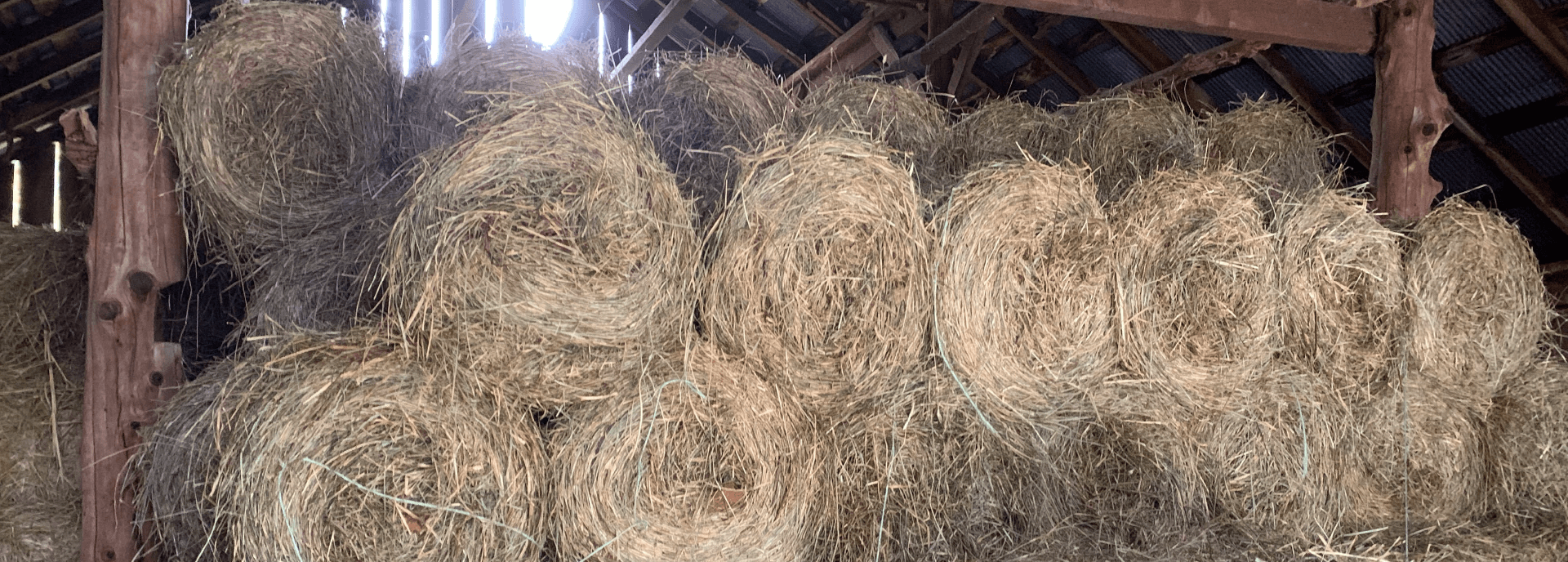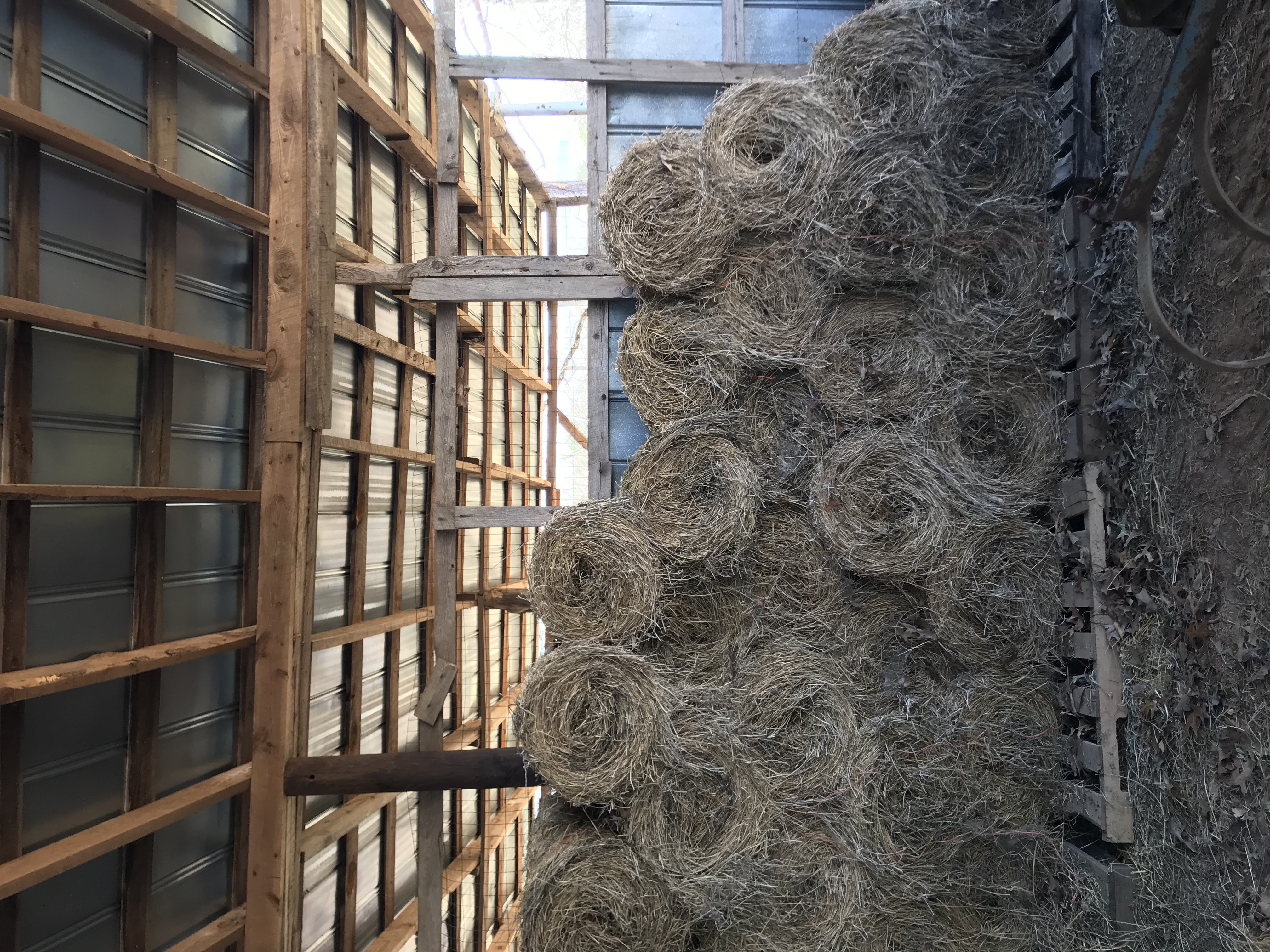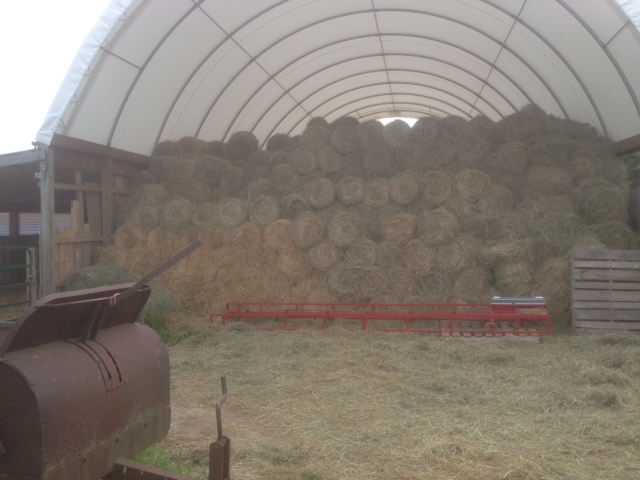Tips for Storing Hay

Hopefully before you’ve even decided to embark on the hay baling adventure, you’ve thought about where you are going to store the bales you produce. The task of baling hay is far too much work to let bales rot in the field. Here are some tips to keep your bales dry and efficiently organized.
The best storage for hay--especially the small round and square bales produced on a small-farm operation--is in a barn or shed. The barn should be free of leaks and well ventilated. Air circulation is important since, oftentimes, freshly baled hay contains moisture which will still need to escape after stacking. Not only can this moisture cause bales to mold, but it can also cause barn fires as was discussed in a previous blog.


Bales should be stacked in a pattern that allows for both ventilation and stability. One example of such a stacking pattern for square bales would be to stack bottom bales on their sides all in the same direction with the cut surface created by the bale edges facing up, allowing for better air circulation. The next layer of bales would then be stacked perpendicularly to the first layer , and so on. Stacking square bales on edge orients most of the hay fibers vertically, allowing air circulation to move upward through the stack. Stacking each layer perpendicularly to the one below will help lock the bales together.
Mini round bales can be efficiently stacked much like firewood with each bale nestling between the two bales beneath it. The key is to have end supports so the bottom row of bales is locked in place. The resulting stack will thus resemble a honeycomb pattern with any space between the bales providing air circulation to further dry the hay and keep it dry. If carefully stacked, the bales should even be tight enough to walk on.

If storing hay outside or in a shelter not protected on all sides, it is important to get your bales up off the ground. This prevents moisture from being wicked up through the soil and creating moldy bales. Using pallets, old tires, fence posts, or beds of rock or gravel under the base layer can achieve this. Anything to break the contact between the bales and the soil is beneficial.
Hay stored outdoors should also be covered with tarps secured well on all corners with tie-downs. A sloped top to your tarp sheds snow and rain better than a flat one and can be achieved by pyramiding the bale stack. Tarping not only keeps bales dry, but also prevents sun bleaching which can reduce nutritional value, particularly that of protein and vitamin A. Be sure to check your tie-downs often especially in windy climates.
Where to store your hay is just one consideration. How to store your hay is another. It is recommended that you develop a system to sort and organize your stored hay. Since different hay cuttings and fields produce forage of different nutritional value, many producers separate their stored hay accordingly. Bales for gestating animals or those for animals simply maintaining condition can thus be easily identified and pulled from the appropriate stack.

Organizing your hay within stacks is important too. New hay should be stacked behind old hay so that you can feed the older hay first. Bales should only be stacked as high as can be safely moved and be easily accessible from at least one side. Be sure to test the stability of your stacks often. Of course it is important that you take some time early in the season to estimate just how much hay you will need to store over the winter to feed you livestock.
This will also allow you to estimate how much extra hay you will have on hand to sell to others. A previous blog titled “Livestock Winter Hay Needs--Hay Calculator” can help you do just that. Using the calculator, you can determine your small farm’s specific hay needs based on the species, number of animals, and conditioning needs of those animals.
Once you know how many bales you plan to store, make sure your space is big enough. The average square or mini round bale will be between 5 and 6 cubic feet. So if, for example, you have calculated that you will need to store 1000 mini round bales, you should plan on having 6000 cubic feet available. How much space is that? It could be a stack 20 feet deep, 50 feet long, and six feet high, or it could be 20 x 30 feet and 10 feet high. Be sure to also plan space for aisles and access and, if possible, to separate different cuttings.
In conclusion, efficient and effective storage of your hay is important. The hours of work to mow, rake, and bale a cutting of hay can be completely wasted with one leaky roof or poorly ventilated stack. Properly storing your hay protects that investment and is always worth the time and effort.
Sources
https://myfarmlife.com/2013/4-best-tips-for-storing-hay/
https://myfarmlife.com/hay-forage/expert-tips-for-storing-and-sorting-hay/
https://www.hobbyfarms.com/how-to-store-hay-to-make-it-last-2/
Recent Posts
-
Boost Pine Straw Production Efficiency with Ibex Mini Round Balers
At Tractor Tools Direct, we're known for our high-quality hay equipment tailored for small farms …Dec 8th 2025 -
How to Winterize Your Tractor: Essential Maintenance Tips to Protect Your Investment
Farm equipment is one of the most valuable investments a farmer can make. At Tractor Tools Direc …Dec 1st 2025 -
Farm Tax ID Explained: Benefits, Eligibility, and How to Apply
As the end of the financial year approaches, it's a great time for small farmer operators to rev …Nov 12th 2025




